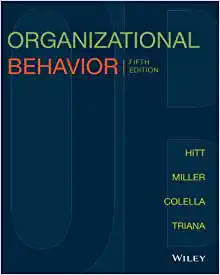What is asked of workers and students these days? Do more with less. Shoulder more of the
Question:
What is asked of workers and students these days? Do more with less. Shoulder more of the costs of doing business or being educated. Do things in new ways and do new things, but do not make mistakes. Do your best, but do not expect it to lead to anything resembling permanency. Earn that degree, but expect to compete with people with experience. Moreover, what are they asking of themselves? Work full time and go to college full time. Start a family with dual incomes, and try to make it on one income to keep a parent home for the child. Let credit cards sustain the myth that you can have it now. Savings are for chumps.
What is a person to do at the vortex of these wrenching contradictions?
Contend with these difficulties and act to overcome them. However, to cope is to contend or strive, especially on even terms or with success. The ethical rub lies in the question of even terms.
Employing managers are, or should be, responsible for creating organizational conditions that keep terms of sustaining one’s employment fair, reasonable, and healthy. Employed individuals are, or should be, responsible for terms of readiness to work, staying healthy, ready for daily engagement, and being open to learning, which they must to adapt to changing demands on the job. This would be coping on even terms. Success is probable.
What if parties on either side do not act responsibly to keep it even? What if manager or worker breaks discipline and allows organizational or personal conditions to overwhelm?
This original exercise engages learners in a simulated moment, when someone “blinks,” either manager or associate. The pressures for unattained results overpower restraints, opening the way for exploitation. Managerial policies or self-discipline is relaxed. The prospect of coping is dimmed or doomed.
Learners ought to remember this silent, physical exercise, when they expect others as managers or are expected as associates by managers to just cope. Is there such a thing as coping on even terms? Who holds the greatest power over the other?
Questions:
1. Arrange for this exercise to happen in a room where people can walk from any point from a wall to the middle of the room without being unduly obstructed. Where there are movable desks, see that spaces are opened, or the desks moved to the walls. Mark the mid-point of the room by stretching a string from top to bottom.
2. Have the class count off in two’s. The One’s go to one side of the room. The Two’s, the far side. The One’s are to be managers. Two’s, associates.
3. Now, form pairs of persons opposite each other. Pair One has a manager on one side of the room and a corresponding associate on the other, and so forth. If there is a third person left, after forming the pairs, ask that person to be an observer.
4. Set the ground rules. Upon your signal, learners on both sides are no longer allowed to talk until further notice. All communicating, if any, will be non-verbal. No physical contact of any sort is allowed.
5. Give this instruction: Upon go, start walking slowly, straight toward your across-the-room partner, keeping your eyes on each other and no one else. Come, all the way to the mid-line, if you are able to do so, without breaking eye contact. On the honor system, if you take your eyes off the other and allow yourself to laugh or otherwise “lose it,” you stop and return to the wall.
6. Those who make it to the mid-line are expected to stand and hold eye contact until time is called or one or the other blinks and the bond is broken. Those pairs that make it to the bell win.
7. Call time, when it is clear to you that those holding eye contact are not going to waver. Both are coping on even terms.
8. Discuss what has happened.
a. Ask those who broke early and did not make it to the mid-line if they will tell the class why. Was it stressful, and if so, how so?
b. Ask those who made it to mid-line, but could not last until time was called if they will tell the class how they got that far, but then lost it. Did feelings of stress increase, as they came closer and looked each other right in the eyes? Why?
c. Ask those who made it all the way to the closing bell about thoughts and feelings that they managed, in order to keep their eyes in steady, sustained contact. How and why did they cope?
d. Explore if more associates broke than did managers, or vice versa and what this may mean about coping on even terms.
e, Ask the class to consider what this exercise teaches in general about managing workplace stress.
9. A speaking version of this exercise may be tried instead of the silent version, or as a contracting round. The rule of holding eye contact is the same. The objective is still to be among the pairs who do not break contact before the closing bell. You may keep the same pairs or have all associates move down one, the one on the end coming back down to fill the open spot.
a. Option 1 is that managers of the pair are allowed to speak, while moving toward their associate. Associates are not.
b. Option 2 is that only the associate may talk. Managers must maintain steely, dignified silence throughout.
c. Option 3 is both parties may talk if they wish.
d. Has speaking helped, or hindered the pair in holding eye contact and managing their emotions?
Step by Step Answer:






